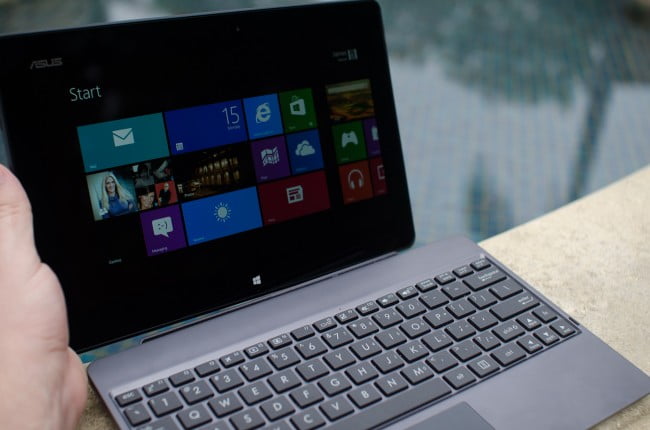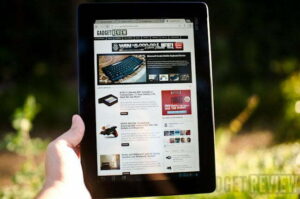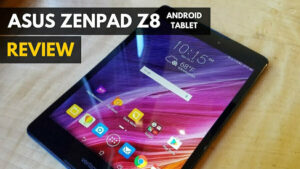Windows 8 is the final maturation of the Windows platform for a touchscreen world. It should come as no surprise then that in many ways Windows 8 is both excellent and flawed, but this review is not about that. Instead, its about the finest Windows RT tablet on the market, the VivoTab T600. If you don’t necessarily need a full keyboard for your tablet, try reading our EVGA Tegra Note 7 Android review to compare. You can also educate yourself about the best Android tablets on the market as you shop for the ideal option for your needs.
And perhaps more importantly, its about the state of tablet computing and how, in so many ways, Microsoft has done something both amazing and terrifying, and ASUS has perfectly enabled the software giant with compelling, powerful, and sleek hardware. If all you need is an e-reader, you might be interested in our Kobo touch review too. If you’d rather have a windows tablet, take a look at our Lenovo Miix 2.8 review instead. While you’re at it, give our Samsung Galaxy Tab Leather Notebook case review a read for a way to keep your laptop safe.
Hardware
The VivoTab T600 is very similar to the beloved ASUS Transformer Pad Infinity TF700T, still the best Android tablet on the market. Compare this tablet with our Archos 101 G9 review to be sure that you’re making the right choice. The VivoTab is a 10.1″ slate with similar components: a 1.3GHz quad-core Tegra 3 T30 CPU, 2GB of RAM, a 1366×768 resolution display with the same Super IPS+ screen technology, and identical front and rear 2MP/8MP cameras, respectively. In case you want a tablet with a slightly higher resolution of 1920×1200, then read the ASUS Transformer Pad Infinity TF700T Review. When looking at theVivoTab T600 specs, there are plenty of differences, but because of the real major difference – Windows RT versus Android 4.0 – the slower CPU, additional RAM, and lower resolution display all make sense for the Windows machine.
It makes sense because, just like on Windows Phone 7 (and now 8), the Windows RT interface is designed around contrasting color, not miniature icons. High resolution pictures aren’t necessary to see what you’re selecting, a brilliant move by Microsoft that I applauded back when WP7 first came on the scene. With WinRT on the VivoTab, the ~720p display is very suitable; 1080p isn’t necessary for such a device, though of course it wouldn’t hurt to have. Considering the current strength of technology, the resolution is proper. And speaking of technology, if you have an Android or iPad tablet, you may be interested in our weekly hack: How to use your Android tablet/iPad as second monitor review.
I’m also very happy with the lower resolution screen because ASUS has done such an incredible job with the IPS panel. It’s not only bright enough for use in direct sunlight, it also provides excellent color contrast and is highly adjustable. Many have claimed that Microsoft’s Surface RT tablet is the definitive WinRT experience, but I disagree. Thanks to an incredibly thin shell, a fantastic display, and a really great keyboard dock, the VivoTab RT is the best way to use Windows RT.
The tablet itself has only a few ports: Micro HDMI out, a MicroSD card slot, and a proprietary connector/charging cable that can connect to the optional docking keyboard, which itself includes a USB 2.0 port and another proprietary connector for charging. The back has a slight design, far removed from the TF700T, which is better designed to grip the tablet from either side with or without the keyboard. I find the feel of the T600 to be exceptional, though in fairness I gave up on a thinner tablet for one with a keyboard (see “Keyboard and Laptop Replacement).
Software
We’ll jump back to the keyboard in a moment, because software is really the more pertinent discussion regarding the T600. As a WinRT tablet, you may think that just like Windows Phone 8 this Microsoft product has limited applications available, and thus limited functionality. That’s only half right. There are only a small number of applications currently available on Windows 8, and for many reasons the number of apps will continue growing slowly, far behind the pace of iOS and Android.
But WinRT does offer a number of things that no tablet today can provide. First and foremost is a true, honest-to-goodness web browser, one capable of Flash and everything else. In so many ways this makes WinRT tablets far more potent than iOS and Android with their hundreds of thousands of apps. You can do almost everything on the internet with a full browser, and while it may be Internet Explorer 10, it’s not a dumbed down tablet version. It’s the actual Internet Explorer. It makes Chrome on Android and Safari on iOS look like a joke when attempting to do anything online that requires flash, still an integral part of the web. The capabilities of Internet Explorer on the VivoTab are only limited by the tablet’s hardware. Because yes, eventually even 2GB of RAM will run out of space under the weight of so many open tabs. Perhaps you want to work with a smaller tablet with a high screen resolution? Read about the ASUS ZenPad Z8 Android Tablet Review.
But more importantly, there may be hundreds of thousands of tablet apps available on iOS and Android, but there are millions of webapps that have been around for years, and most of them are completely free. Photo editing, video editing. millions of flash games, chat applications…if you can think of it, someone has likely made it available online, so long as it isn’t too big and it doesn’t require downloading any executable files.
The second thing that sets WinRT apart is Office 2013, or more specifically the three main Office applications that come free with all WinRT tablets: Word, Excel, and Powerpoint. It also comes with Microsoft OneNote, an excellent note-taking application that is unfortunately rarely used. What sets WinRT apart from Apple’s iWork suite for the iPad and the multitude of office applications on Android is twofold: on WinRT they are completely free, and they are identical to the typical desktop versions. Just like Internet Explorer, the Office apps aren’t a dumbed-down tablet version. They are the real deal.
Then there’s what I consider the absolute coolest part of WinRT: the desktop view. Android and iOS are completely new operating systems that don’t function like a traditional computer OS. Not so with WinRT. With the hit of a button you can work from a Windows 7 desktop environment. All of the built-in applications are there, from Internet Explorer and Office to Paint and Calculator. However, users can’t access the same start menu; that remains identical to Windows 8. So if you don’t feel comfortable switching to a tablet-style OS, WinRT gives users options: the familiar desktop view where nearly everything is the same (down to the control panel and power settings), or the new touch-driven user interface.
There is one catch to the desktop view: it isn’t a true Windows desktop experience. WinRT, due to its ARM processor architecture, doesn’t run applications as a typical Windows computer does, so every program was remade specifically for RT. That also means that if you want to download your favorite programs to use on the VivoTab, chances are you won’t be able to do that. Because no matter how much WinRT looks and feels like a traditional desktop in the desktop view, it isn’t. That’s where the most serious limitation of the platform is; then again, no other OS offers a desktop work environment; we should be so fortunate to complain that something this new doesn’t do so much more that the competition can’t even begin to do.
However, my experience is that 80% of the time the T600 was able to replace my laptop for most simple use. The biggest difficulties come from the hardware (ARM processors are still wildly underpowered compared to traditional x86/64-bit chips), and from using webapps instead of built-in apps. On some occasions I’ve found that some webapps require downloading .exe files to run properly, which in turn makes them unusable on the T600, but those instances are rare. It’s not a perfect system, but if IE10 could have extensions in the place of standard upgrade/update files, it would improve on the quality of WinRT tablets immensely.
Keyboard and Laptop Replacement
One of the best things about the VivoTab RT is the keyboard dock, a $100 accessory that doubles as a keyboard and battery dock, effectively doubling the already long battery life of the tablet. The keyboard itself is great to excellent. It has two design flaws: the trackpad is tiny and is too easy to press when typing; and the slightly lowered keyboard was built to maximize battery space but the spacebar is surprisingly difficult to press because of the chassis.
Those two things aside, the VivoTab’s keyboard provides excellent type and is very comfortable to use, at least once users adjust to the strange shape around the keyboard. I have also found that after plenty of travel and use the docking clamp doesn’t securely connect to the tablet properly. In the bag the two will disconnect and reconnect constantly; just shaking it while typing may cause the two to disconnect briefly. Thankfully WinRT is very quick with the device and every time the keyboard disconnects, it reconnects almost instantly, fast enough to never notice the disconnect when typing.
Of course, with a keyboard that acts as a dock, a battery, a case, and a keyboard, it’s very easy to mistake the T600 for a small laptop. In several meetings people have done exactly that, shocked that I had such a thin laptop that comes complete with a touchscreen. It should come as no surprise that they are even more shocked to see the two pieces separately. However, using the VivoTab as a laptop only goes so far.
For starters, the 2GB of RAM becomes tiny under too many open documents, photos, and web pages. The processor feels slower than a traditional computer as it should; not for minor tasks like typing in Word or simple web browsing, but in heavier web applications like Gmail. With 4-5 tabs open the T600 slows to a crawl or the other tabs slip into standby mode and need to be reloaded to be reactivated. If you live in tens of tabs, then WinRT is not a suitable laptop replacement until more powerful processors and more RAM become available on tablets.
There are, however, many instances where WinRT does perform just like a laptop, against expectations. The T600 (with the keyboard dock or USB adapter) is capable to install external hardware peripherals like mice, keyboards, and headsets that don’t connect via Bluetooth, such as Logitech’s Unifying 2.4GHz band or Sony’s 2.4GHz dongles for wireless headsets. They just work, no installation necessary. One device, the Logitech Presentation Remote R800, has a sole purpose: to go between slides for presentations. The USB dongle works perfectly on WinRT, which made it far more convenient to use than a larger laptop because of the far better battery life and portability.
Is the VivoTab worthy of replacing a laptop? No, certainly not, though perhaps with the latest ARM A15 processors and 3GB of RAM or more that may change. Such devices may be available late this year. As for the T600, as a laptop replacement it is excellent as a media playback device, a simple typing and web-browsing laptop, and even with a ton of use the 18-20 hours of battery life with the keyboard dock make it lovely to use.
Use & Battery Life
From specs alone, the VivoTab T600 seems like it could go either way, as a very potent, powerful tablet, or as a decent but not particularly speedy one. The strange truth is that because of the nature of WinRT and how people use it, it’ll be very difficult to pinpoint exactly whether it’s a very fast or only mediocre tablet.
Real world use is give and take. The problem I ran into was my constant use of the desktop, not the Windows 8 UI. In other words, I found it far more convenient to use the T600 as a laptop that was also a tablet instead of a tablet that could work like a laptop. If you plan on the former, it’ll appear slow. For the latter, it’ll feel like a dream come true.
The reason for that is the exceptional battery life. The VivoTab, like most tablets today, boasts a strong 8.5 hours of battery life. This time is consistent with my use, but more importantly doubled when connected to the keyboard dock. That is to say that users can get up to 17 hours of use out of the VivoTab T600 with the keyboard dock. That’s unprecedented, and it’s something that no other tablet today can boast. Combine that with the native Windows desktop and even if the performance isn’t quite what you were looking for, there is no comparison for longevity. This tablet is what netbooks failed to be.
Conclusion

I’m very torn about the VivoTab. On the one hand it’s a proof of concept that yes, Microsoft still has something to show in the world of tablets, though perhaps Windows RT isn’t quite it. It feels too much like Windows 7 Starter, a joke of an OS that nobody really wanted and lacked too many pertinent features. The difference is clear: WinRT is meant as a low-priced solution for a low-power device. It is the rebirth of netbooks, but done right: with an excellent form factor (the tablet), exceptional battery life, reasonable power, and a brilliant display.
But then there’s a question of what exactly is the purpose of a tablet. Is it to eventually replace laptops? If so, then the VivoTab is certainly a step in the right direction, but WinRT isn’t the right platform for such a future. Nor is the Tegra 3 processor and 2GB of RAM, both of which pale in comparison to the typical laptop today sporting Intel i5/i7 chipsets with up to 8GB of RAM and a half-decent GPU. Hardware performance may not be the concern for much longer, but the inability to run executable files is an issue. I know that as much as I’d love to use the VivoTab for all my mobile computing needs, I can’t unless I’m willing to give up a lot of programs I like to use in place of web-based applications. And if I don’t have an internet connection, then I’m out of luck.
No matter what anyone can say though, these are problems that cannot be found on Android or iOS. Neither platform even supports a desktop UI, let alone .exe files. They are dumb devices when it comes to web browsing and general use, made for a touchscreen but completely out of place with everyday computing. Sometimes we need one, and other times we need the other. Only Windows tablets offers both, and as far as WinRT tablets go, there is nothing better than the VivoTab RT T600.

